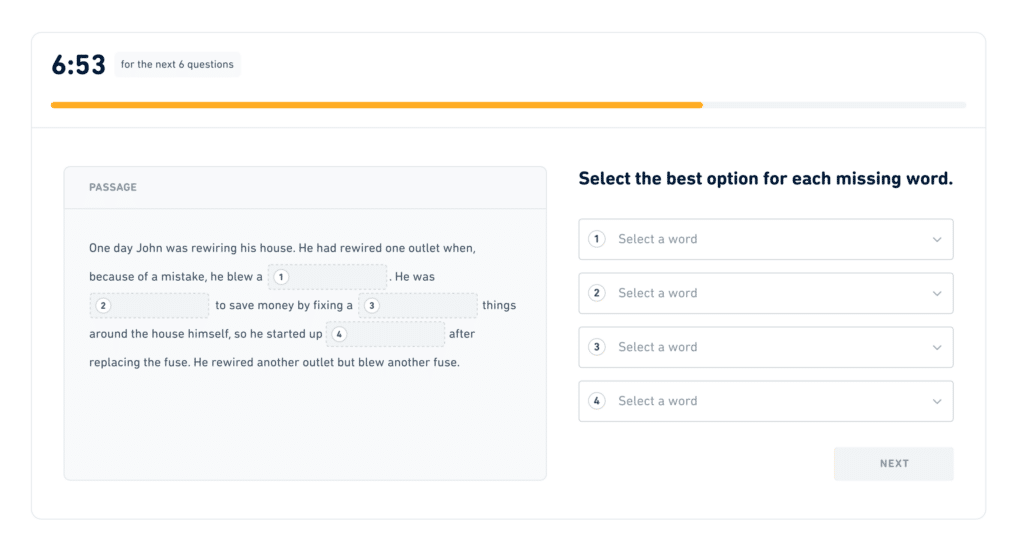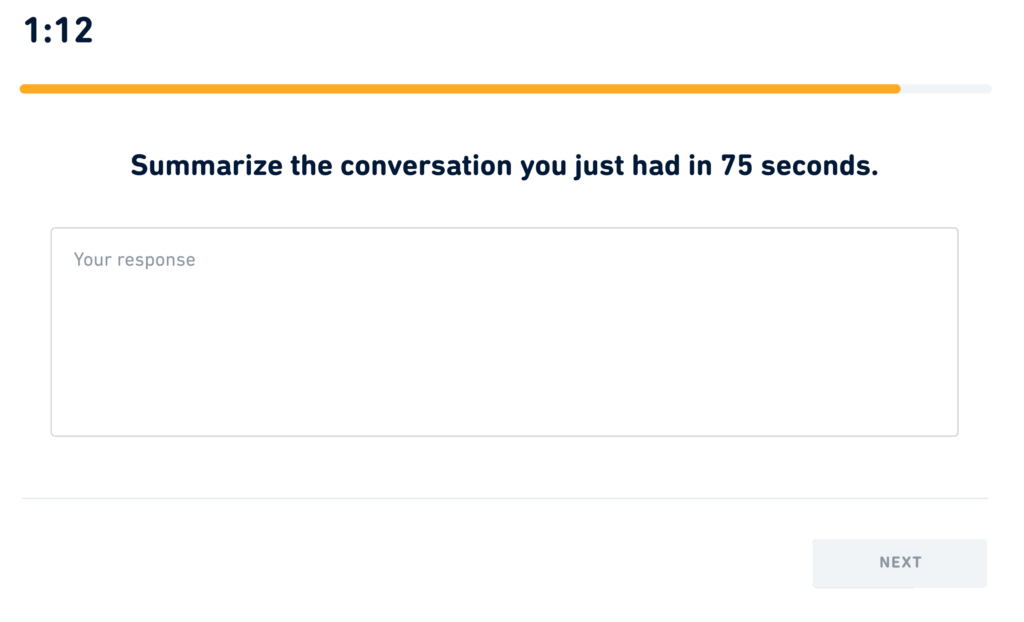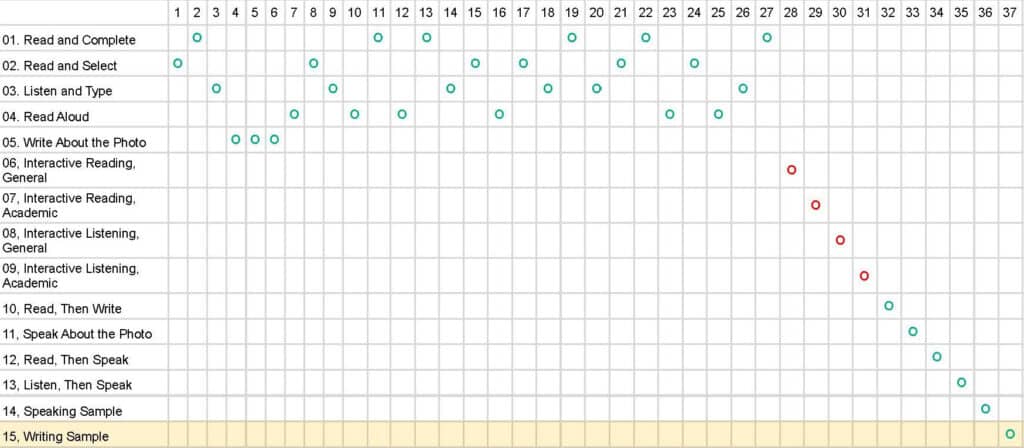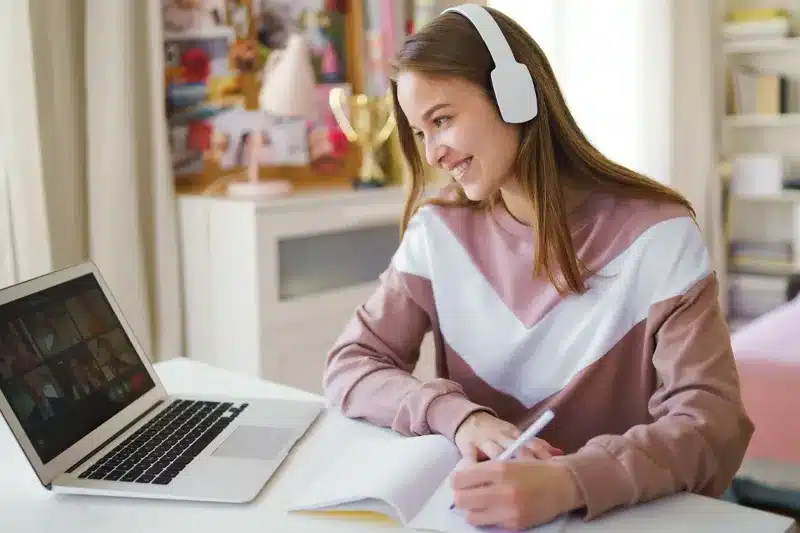

Duolingo English Practice Test with Answers
Ready to take a free and complete Duolingo English Practice Test®? All you need is one hour and an open mind. Are you ready? Check out the video here and the PDF version of the test here.
But wait!
Taking a practice test is only half the battle. You also need to learn about the structure of the test and how to study in a way that will help improve your score.
By the end of this short article, you will know how the Duolingo English Test is structured and how the question types will look. I will also share my top five tips for students studying on their own who need to improve their test score.
Let’s jump right in.
The Duolingo English Test structure
The TOEFL iBT® and IELTS® exams are organized based on sections. In the TOEFL iBT®, for example, you begin with the Reading, and then move on to the Listening, Speaking, and Writing sections.
The Duolingo English Test® is a completely different experience.
The main organizing principle you must become familiar with is the question types and how frequently they show up on the exam. The first five question types show up between three to six times during the first half of the test.
Duolingo English Test Question Types |
|||
|---|---|---|---|
| Question Types | Frequency | Adaptive | Subscore |
| 01. Read and Complete | 4-6 | ◯ | Comprehension, Literacy |
| 02. Read and Select | 4-6 | ◯ | Comprehension, Literacy |
| 03. Listen and Type | 4-6 | ◯ | Conversation, Comprehension |
| 04. Read Aloud | 4-6 | ◯ | Conversation, Comprehension |
| 05. Write About the Photo | 3 | X | Literacy, Production |
Keep in mind, besides Write About the Photo, these question types are adaptive, so they will remain easy or become more difficult as you progress through the exam.
The next part of the exam will consist of Interactive Reading and Interactive Listening passages. These are the latest additions to the test. Expect two short reading passages between 100 to 200 words. You will have seven or eight minutes to answer six questions about each passage.

The Interactive Reading will be followed by the latest addition to the Duolingo English Test, Interactive Listening. This part will also consist of two passages. One passage will be a conversation between two students about something related to campus life, and the second passage will be between a student and a campus worker, usually a professor. You will participate in the conversation, answering five or six questions. After the given passage is finished, you will have 75 seconds to write a summary of the conversation.


Duolingo English Test Question Types |
|||
|---|---|---|---|
| Question Types | Frequency | Adaptive | Subscore |
| 01. Read and Complete | 4-6 | ◯ | Comprehension, Literacy |
| 02. Read and Select | 4-6 | ◯ | Comprehension, Literacy |
| 03. Listen and Type | 4-6 | ◯ | Conversation, Comprehension |
| 04. Read Aloud | 4-6 | ◯ | Conversation, Comprehension |
| 05. Write About the Photo | 3 | X | Literacy, Production |
| 06. Interactive Reading, 2 passages | 12 | X | Literacy, Comprehension |
| 07. Interactive Listening, 2 passages | 12-14 | X | Conversation, Comprehension, Literacy, Production |
The remaining question types involve extensive writing and speaking responses. These questions are not adaptive, and each shows up once, besides Listen, Then Speak, which may show up twice.
Duolingo English Test Question Types |
|||
|---|---|---|---|
| Question Types | Frequency | Adaptive | Subscore |
| 01. Read and Complete | 4-6 | ◯ | Comprehension, Literacy |
| 02. Read and Select | 4-6 | ◯ | Comprehension, Literacy |
| 03. Listen and Type | 4-6 | ◯ | Conversation, Comprehension |
| 04. Read Aloud | 4-6 | ◯ | Conversation, Comprehension |
| 05. Write About the Photo | 3 | X | Literacy, Production |
| 06. Interactive Reading, 2 passages | 12 | X | Literacy, Comprehension |
| 07. Interactive Listening, 2 passages | 12-14 | X | Conversation, Comprehension, Literacy, Production |
| 08. Read, Then Write | 1 | X | Literacy, Production |
| 09. Speak About the Photo | 1 | X | Conversation, Production |
| 10. Read, Then Speak | 1 | X | Conversation, Production |
| 11. Listen, Then Speak | 1-2 | X | Conversation, Production |
| 12. Speaking Sample | 1 | X | Conversation, Production |
| 13. Writing Sample | 1 | X | Literacy, Production |
You can find more information on these questions in Duolingo’s Test Readiness Guide.
Now you know about the question types!
Still, if you’re anything like me, it’s tough to imagine how these questions will be presented on test day. Keep in mind that you will encounter one question at a time and can expect between 35-40 questions on test day, excluding the Interactive Reading and Listening. The Interactive Reading will consist of an additional 12 questions, and the Interactive Listening is usually 12 questions as well, adding up to a total sum of approximately 60 questions. Below is a question flow example of a typical Duolingo English Test.

Note that this is just an example, and do not expect to encounter the questions in the same order on test day. Here are three of the most important things to keep in mind when preparing for the exam structure:
- Speak About the Photo; Read, Then Speak; Read, Then Write; and Listen, Then Speak, Speaking Sample and Writing Sample usually appear at the end of the test.
- Write About the Photo questions appear during the first half of the test and usually consist of three consecutive questions.
- Read and Complete, Read and Select, Listen and Type, and Read Aloud questions will appear approximately six times and adapt in difficulty depending on your performance.
If you haven’t done so already, I recommend taking a practice test over at the Duolingo English Test website or check out our complete Duolingo English Test practice PDF for a better idea of how the test looks and feels.
Five tips to improve your Duolingo English Test score
Tip #1 – Speak and write as much as possible
There are seven question types in the Duolingo English Test where you will have to produce your own speaking and writing responses:
- Write About the Photo
- Speak About the Photo
- Read, Then Write
- Read, Then Speak
- Listen, Then Speak
- Speaking Sample
- Writing Sample
The directions for each of these questions will inform you of the least amount of words you have to write or the least amount of seconds you have to speak. No matter what the minimum requirement is, aim for the maximum.
For all three speaking questions, you are instructed to speak between 30-90 seconds; aim for 90 seconds.
For Write About the Photo questions, write as much as possible in the 60 seconds you are provided.
For Read, Then Write questions, write as much as possible in the 5 minutes you are provided.
Part of your grade is based on your grammatical and lexical complexity. The more you write and speak, the more opportunities you will have to show a wide range of grammar and vocabulary. If you hurry through these questions and follow the minimum requirements, it will be difficult to earn a score higher than 120.
Tip #2 – Plan out your week
When you begin to prepare for the Duolingo English Test, you will find a ton of free and paid resources that you can use to prepare for the exam. All of these materials are extremely helpful, but overwhelming. It is confusing when you sit down at your desk and try to figure out where to start.
A quick fix is to take an hour out of your day on Sunday and plan out your week. People do this when they diet. They prepare their lunch for Monday to Friday on Sunday, store it in the fridge, and grab each day’s pre-prepared meal without thinking about it. Do the same for your studies.
Set the time, place, and materials you plan to use Monday through Friday so you know what to do each day of the week. And then take Saturday off; you’ve earned it.
Tip #3 – Challenge yourself
Search any of the following question types on YouTube, and you will find examples to practice. Remember, the Duolingo English Test contains four adaptive questions that become more difficult if you perform well at the beginning of the test.
- Read and Complete
- Read and Select
- Listen and Type
- Read Aloud
Do the harder questions. Seriously. Challenge yourself. When you practice with more complex problems at home, it will build your confidence and improve your performance on test day.
Tip #4 – Record your voice
Speaking and writing questions are the hardest to prepare for because they require feedback from someone, usually a teacher, which is why I recommend working with a Duolingo English Test instructor like this one.
However, many test-takers will prepare on their own, which is why it is critical that you record your voice when you practice speaking. After you record your voice, listen back to your response and identify one or two ways you can improve. After that, do the same response again.
Here is an example of the questions you should ask yourself after recording your own response.
Speak About the Photo Self-Grading Rubric |
|
|---|---|
| Questions | Notes |
| 1. Did I speak for at least 45 seconds? | |
| 2. Did I start by describing the foreground? | |
| 3. Did I provide additional details or inferences to expand on the foreground? | |
| 4. Did I give a description of the background? | |
| 5. Did I make at least two inferences in my response? | |
| 6. Did I provide enough descriptive words and specific vocabulary? | |
| 7. Did I speak at a natural and conversational pace for the majority of my response? | |
| 8. Did I have less than five vocal fillers (uh, um)? | |
| 9. What can I do next time to improve my score? | |
Tip #5 – Set up your testing environment
“Your test score could not be validated.”
You do NOT want to see this message on your score report. Unfortunately, this happens to a ton of students. Since the Duolingo English Test is a completely automated testing experience, there is extensive technology in place that tracks your eye movement, mouse movement, computer behavior, and room environment to ensure that you do not cheat when you take the exam.
Here are a few key points to keep in mind when you are setting you your testing environment for the Duolingo English test:
- Keep your eyes on the computer. If you look away for too long, it will invalidate your score.
- Do not have any other browser window open. If you try to navigate away from the test, it will invalidate your score.
- Take the test in a well-lit room. If you are ever in the dark, it will invalidate your score.
- Be sure you are alone in a quiet room. If there is too much background noise, it will invalidate your score.
- Check your microphone and Internet connection. If at any point your Internet connection drops off or your microphone does not work, it will invalidate your score.
- You are not allowed to use headphones during the test. Be sure your computer speakers work.
If you have made it this far, you are ready to take the practice exam for the Duolingo English Test. Take it here right now.
But what do you think? Are there any tips I missed that you believe would be helpful for students studying for the Duolingo English Test? Be sure to leave it in the comments below. I respond to all of them.
Good luck and see you in the next one. Don’t forget to claim your free practice test.
Also read:
Create a FREE
Practice Account
Join now and start learning with our free materials






101 Comments
Comments navigation
Meseret
I took the Duolingo test, but I didn’t get a scholarship. Please, help me!
Josh
Hi Meseret. I would suggest doing a Duolingo evaluation with us so we can see how to best help you.
Anjan
Hi Josh,
I have taken your Udemy course and completed all modules, but I was stuck with a 105 score. However, I need 120 overall, which I need to improve my score within a shorter duration; additionally, I got a conditional offer, so I need to submit my score to the university. Please guide me to where I’m lagging, and please inform me if you’re doing any crash courses for this test or if anyone is doing it. I appreciate your response; thanks in advance.
Josh
Hi Anjan, thanks for your question. Sorry to hear are having trouble getting to 120. The best suggestion would be to do a 30 minute evaulation with us. This way, it might be easier to see which part of the test you need to focus on.
Brittany
Hi, I have two questions about the Duolingo Test from a student. I was wondering whether you can help… Will you be penalised for not using American English (colour/color, organised/organized)? Are there any concessions to help a student with dyslexia? I would really appreciate your response or the contact of someone I can ask.
Josh
Thank you for your questions. My understanding of both American and British English will be considered correct, I believe there are accommodations for students with certain special needs. The best course of action would be to contact Duoling and ask them what documentation you would have to provide.
Banin
Hello, could you please respond me that what is my level? I received 90-110 in the free Duolingo English test.
Josh
Hi Banin, Thanks for your question. It is important to say that a practice test won’t always give accurate results, especially with speaking. That being said, your score would suggest your level of English is somewhere between intermediate and upper intermediate.
Hope
Sir, I would love to ask what the overall score you need to pass the DET is exactly?
Josh
Thank you for your question. There is no set score. The institution you are applying to will set its own guidelines. Please make sure to check with them. Thank you 🙂
Comments navigation